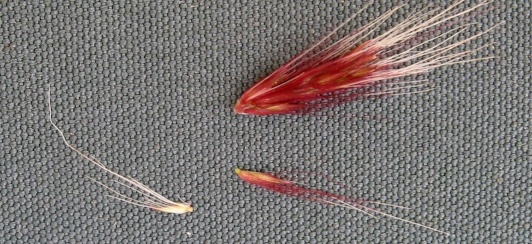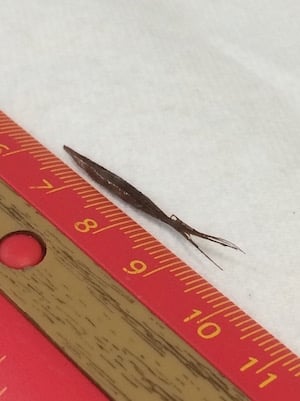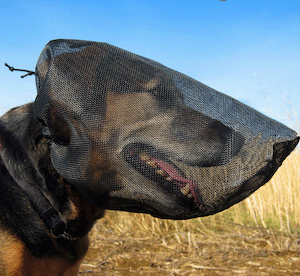 If you have a dog, you probably have heard of foxtails, also called “grass awns.” In the spring and summer months, they can wreak havoc on your pup.
If you have a dog, you probably have heard of foxtails, also called “grass awns.” In the spring and summer months, they can wreak havoc on your pup.
Foxtails can lodge into your dog’s ears, paws, and nose, sometimes with serious consequences.
Foxtails are widespread, near impossible to avoid, and pose a real danger to your dog if left unchecked. But don’t start thinking you need to go into permanent indoor hiding. You can do a lot to keep your dog safe from foxtails.
Read on for tips to help you identify what foxtail grass looks like, where they are, and how to keep your dog safe. You’ll also learn what to do when you suspect your dog has a foxtail injury.
What Is a Foxtail & What Does it Look Like?
Why Are Foxtails Dangerous for Dogs?
Signs Your Dog Has a Foxtail Injury
How to Remove a Foxtail
How to Prevent Foxtail Injuries
What Is a Foxtail?
Foxtails are seed-like structures that are found at the tops of grasses. Foxtail can be any of the weedy grasses in the Alopecurus or Setaria genera of the Poaceae family (and there are around 25 species just within the Alopecurus!).

Where Is Foxtail Commonly Found?
Foxtails are most commonly found in late spring, summer, and early fall. Put simply, foxtails are found just about everywhere throughout North America.
In fact, foxtails are reported to thrive in all but 7 states in the U.S.: Florida, Georgia, Hawaii, Louisiana, North Carolina, South Carolina, and Virginia.
In western states like California, they can exist all year long. You’ll see foxtails, most commonly along the sides of hiking trails, next to roadways, in open fields, and even in your backyard.
What Do Foxtails Look Like?
Foxtails have sharp, pointy tips and are designed to burrow. Due to the unique shape of this seed, it’s always moving forward — never backward. This is how they spread in nature and how they cause problems for your dog.
Why Are Foxtails Dangerous for Dogs?
The sharp, pointy tip can lodge into your dog’s skin, paw, nose, ears, eyes, and mouth and cause a painful infection if left untreated. Sometimes, dogs eat a foxtail, and this can be an emergency because it can perforate the intestine or cause a severe infection leading to an abscess. Both cases may require emergency surgery. This photo is of three foxtails after removal from a dog's injury:
 This video shows how quickly and easily a foxtail can burrow into your dog's skin:
This video shows how quickly and easily a foxtail can burrow into your dog's skin:
How to Tell if Your Dog Has a Foxtail Injury
Depending on where the foxtail has lodged, there are different symptoms to look for. The most common places for foxtails to be found are the paws, ears, and nose. Sometimes, they can even lodge in your pup's eyes or mouth. They can also be inhaled. In fact, that's what happened to poor Mudge here:
If you see any of these signs during foxtail season, you should bring your dog to the vet.
How to Tell if Your Dog Has a Foxtail in Their Paw
- Constant licking between the toes
- Limping
- Swelling or discharge between the toes
Just take a look at this poor pup's foxtail paw injury:
The post's caption reads: "The x-ray on the left is of a foxtail tract that was injected with contrast medium to show just how far a foxtail can travel. The lesion between the toes of the foot on the bottom right is how these tracts will look to the naked eye. This is a great example of just how far foxtails can migrate in tissues. Thank you to Dr. Andrew Grange from Veterinary Surgical Centers in Berkeley for this amazing x-ray."
How to Tell if Your Dog Has a Foxtail in Their Ear
- Head shaking
- Pawing at the ear
- Head tilt
- Pain when head or ear is touched
- Redness and discharge from the ear
How to Tell if Your Dog Has a Foxtail in Their Nose (or has Inhaled One)
- Sneezing
- Coughing/gagging
- Difficulty breathing
- Discharge from the nose that may or may not be bloody
- Sudden onset of bad breath
How to Tell if Your Dog Has a Foxtail in Their Eye
- Squinting/pawing at the eye
- Discharge from the eye: The discharge can be clear or slightly yellow or green, and rarely any blood
- Swelling around or in the eye
How to Tell if Your Dog Has a Foxtail in Their Genitalia
- Excessive licking of genitals
- Blood in urine
This photo shows a large (almost 3 inches!) foxtail removed from a cat's hind end:

Questions? If you're concerned about foxtails and want to chat with a veterinarian, Click here
How to Tell If Your Dog Has an Infected Foxtail Injury
- Lack of energy
- Lack of appetite
- Swelling, bleeding
- Rancid smell coming from a wound
Anytime your pup seems lethargic, has a strange smell coming from a wound or a swelling somewhere on their body, or is licking excessively in one spot, it is best to have it checked out by your veterinarian. Foxtail injuries are treated successfully the earlier they are found.
How to Remove a Foxtail from Your Dog
It is best to examine your dog immediately after walks or hiking in areas where foxtails are prevalent. Catching a foxtail before it lodges into any of the areas noted above is the best prevention.
You can use a fine-toothed comb or a brush to remove foxtails from the fur. Check between the toes and paw pads and their ears — these places where foxtails most commonly lodge.

Most foxtails that are stuck in your dog’s fur (and not embedded in their skin) can be removed easily with just your hands. If you find a foxtail that has slightly embedded itself somewhere, you can use tweezers to try and remove it. Once removed, wash the area gently with antibacterial soap and thoroughly rinse the area with tap water.
If you are unsuccessful, or if the foxtail is deeply embedded in your dog's skin, then see your vet ASAP to have them remove it. Your vet will be able to provide pain medication and antibiotics if necessary so that an infection does not develop. In the video below, Dr. Rode removes a foxtail from a dog's nose. Thankfully it turned out well!
How to Prevent Your Dog from Getting Foxtail Injuries
Since it is almost impossible to get rid of foxtails in the environment, prevention of foxtail injuries is the best way to never have to deal with a foxtail catastrophe.
When out walking your pup, avoid places where foxtails are prevalent. Keeping your pup on a leash can also help them avoid areas where foxtails grow. Foxtails are commonly found in tall grasses that are off the main walkways or hiking paths. Avoid letting your dog run through open fields of tall grass during the foxtail season, typically late spring, summer, and early fall.

Some dogs – like hunting dogs, may need extra protection. For these dogs, the OutFox Field Guard can be extremely helpful for protecting their eyes, ears, and mouth.
For paw protection, there are many types of booties on the market that can help protect the paws. Ruffwear and Muttluks have a nice selection. For more tips on paw protection and care, check out, How to Properly Care for Your Dog's Paw Pads.
Even if you use one of these products, you should still check for grass seed awns and brush out your dog’s coat after any walk. That being said, these tools can help spare you and your dog significant pain and financial expense!
In your own yard, you can prevent foxtail hazards by mowing your lawn regularly and controlling weeds.
Even despite your best efforts, foxtails can be sneaky and stubborn. Even the most conscientious owner can miss a foxtail injury. Luckily, it is very rare for a foxtail to be so serious that it causes death. However, early treatment is key. So, anytime your pup is lethargic, has a wound that will not heal, or is limping, seek veterinary care as soon as possible.



